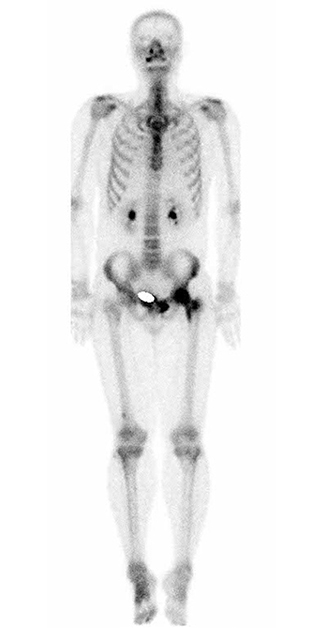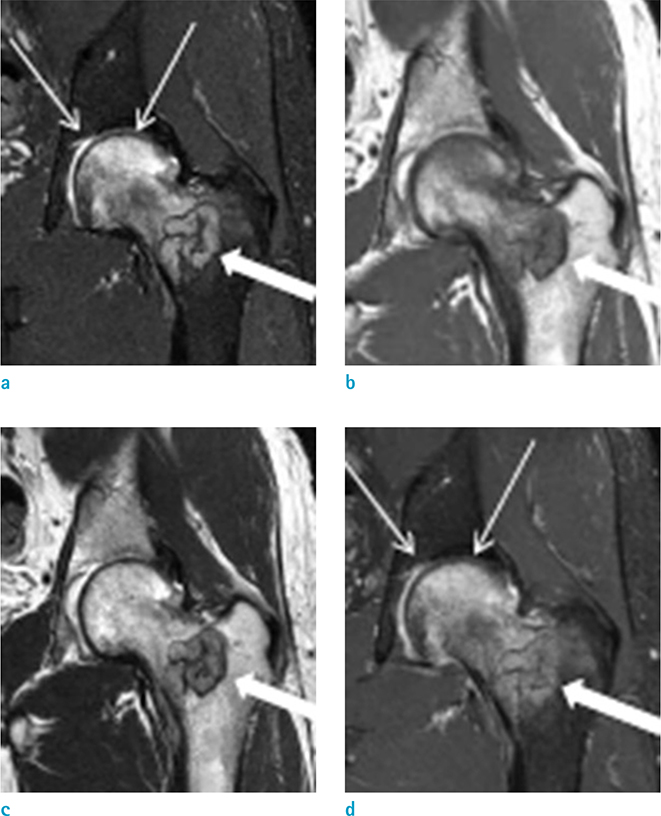Investig Magn Reson Imaging.
2017 Sep;21(3):177-182. 10.13104/imri.2017.21.3.177.
An Intraosseous Schwannoma Combined with a Subchondral Fracture of the Femoral Head: a Case Report and Literature Review
- Affiliations
-
- 1Department of Radiology, Kyung Hee University Hospital, College of Medicine, Kyung Hee University, Seoul, Korea. t2star@naver.com
- 2Department of Pathology, Kyung Hee University Hospital, College of Medicine, Kyung Hee University, Seoul, Korea.
- 3Department of Orthopedic Surgery, Kyung Hee University Hospital, College of Medicine, Kyung Hee University, Seoul, Korea.
- KMID: 2392689
- DOI: http://doi.org/10.13104/imri.2017.21.3.177
Abstract
- Schwannomas are benign nerve sheath tumors that are typically located in soft tissue. Occasionally, schwannomas involve osseous structures. These intraosseous schwannomas are generally benign neoplasms that account for less than 0.2% of primary bone tumors. Schwannomas are very rarely observed in long bones. We present a case of a schwannoma affecting the proximal femur with a coincident subchondral fracture of the femoral head. A 38-year-old-male presented with left hip pain without deteriorating locomotor function. Plain film radiographs displayed a lobulating contoured lesion within the intertrochanteric portion of the femur. The magnetic resonance imaging (MRI) scans showed a tumor occupying the intertrochanteric region. Diffuse bone marrow edema, especially in the subchondral and head portions of the femur that was possibly due to the subchondral insufficiency fracture was also noted. The lesion was surgically excised and bone grafting was performed. Histologically, there was diffuse infiltrative growth of the elongated, wavy, and tapered cells with collagen fibers, which are findings that are characteristic of intraosseous schwannoma. Although very rare, intraosseous schwannoma should be included in the differential diagnosis of radiographically benign-appearing, non-aggressive lesions arising in the femur. The concomitant subchondral fracture of the femoral head confounded the correct diagnosis of intraosseous schwannoma in this case.
MeSH Terms
Figure
Reference
-
1. Bansal AK, Bindal R, Shetty DC, Dua M. Rare occurrence of intraosseous schwannoma in a young child, its review and its pathogenesis. J Oral Maxillofac Pathol. 2012; 16:91–96.2. Simsek HO, Aksoy MC, Can C, Baykul T. Intraosseous schwannoma of the mandible. Int J Exper Dent Sci. 2012; 1:48–50.3. Sorensen SA, Mulvihill JJ, Nielsen A. Long-term follow-up of von Recklinghausen neurofibromatosis. Survival and malignant neoplasms. N Engl J Med. 1986; 314:1010–1015.4. Hoshi M, Takada J, Oebisu N, Nakamura H. Intraosseous schwannoma of the proximal femur. Asia Pac J Clin Oncol. 2012; 8:e29–e33.5. Gine J, Calmet J, Sirvent JJ, Domenech S. Intraosseous neurilemmoma of the radius: a case report. J Hand Surg Am. 2000; 25:365–369.6. Suzuki K, Yasuda T, Watanabe K, Kanamori M, Kimura T. Association between intraosseous schwannoma occurrence and the position of the intraosseous nutrient vessel: A case report. Oncol Lett. 2016; 11:3185–3188.7. Vora RA, Mintz DN, Athanasian EA. Intraosseous schwannoma of the metacarpal. Skeletal Radiol. 2000; 29:224–226.8. Imaizumi A, Kodama S, Sakamoto J, et al. Imaging findings of benign peripheral nerve sheath tumor in jaw. Oral Surg Oral Med Oral Pathol Oral Radiol. 2013; 116:369–376.9. Weiss SW, Goldblum JR, Folpe AL. Enzinger and Weiss's soft tissue tumors. Philadelphia, USA: Elsevier Health Sciences;2007.






